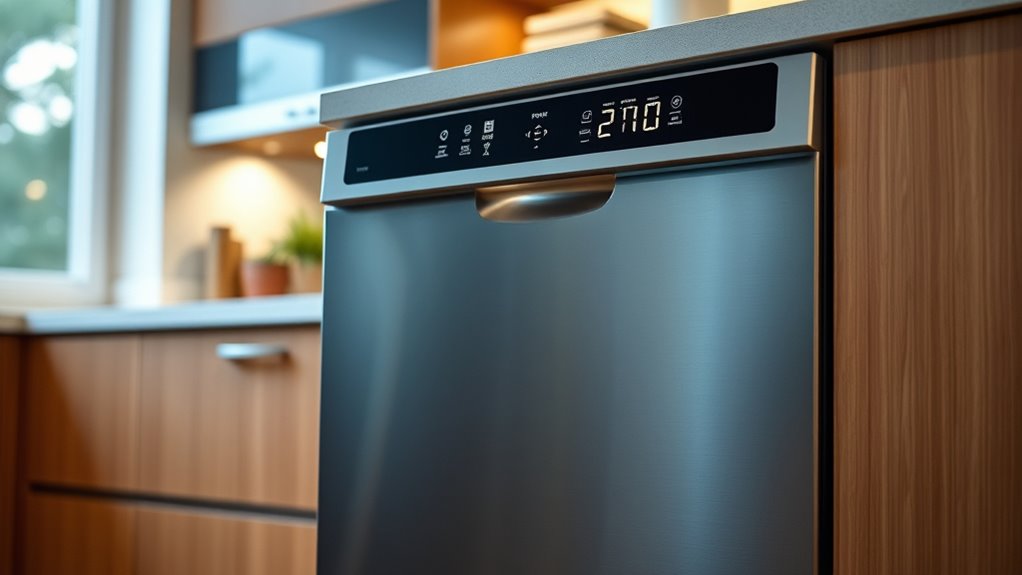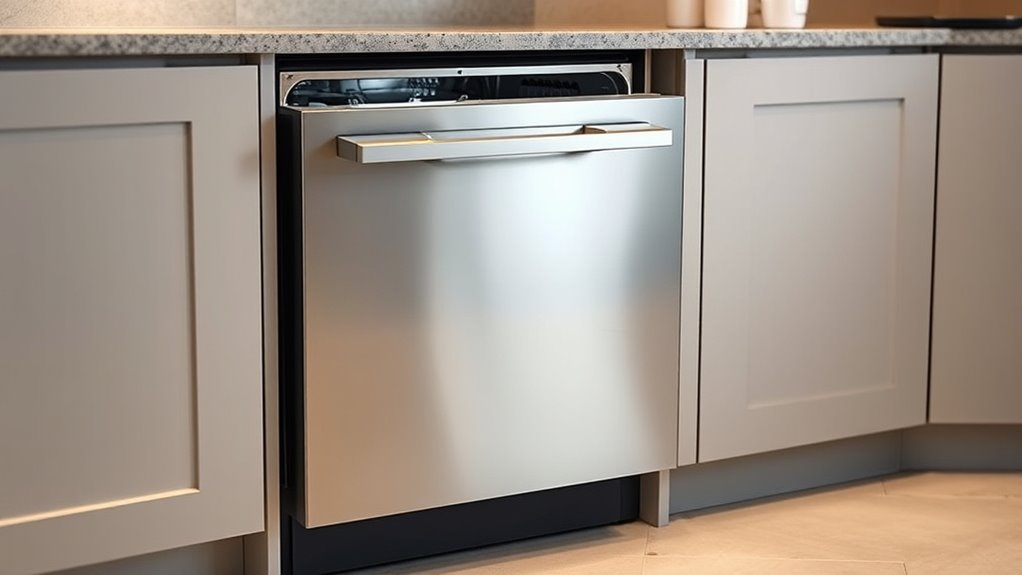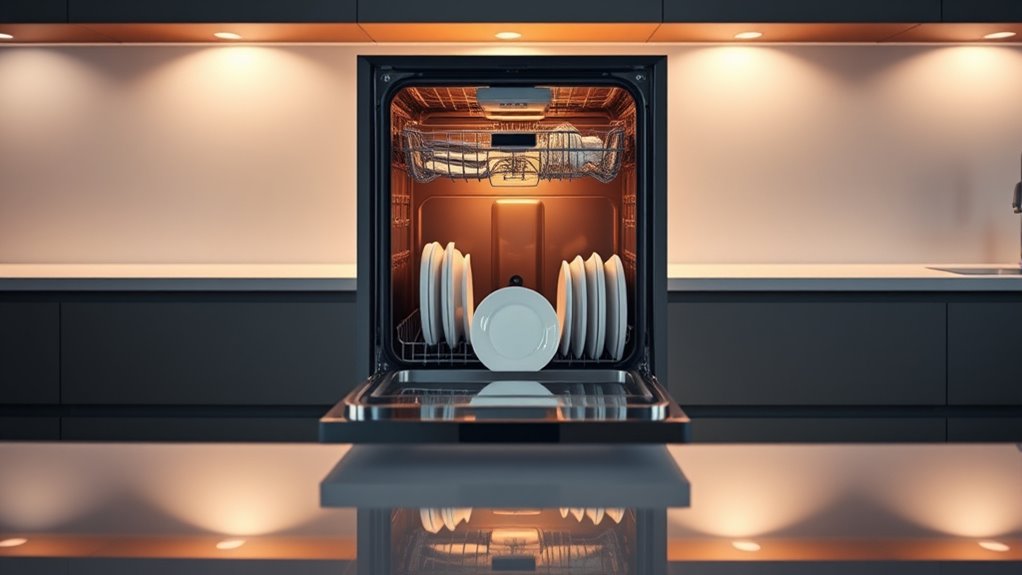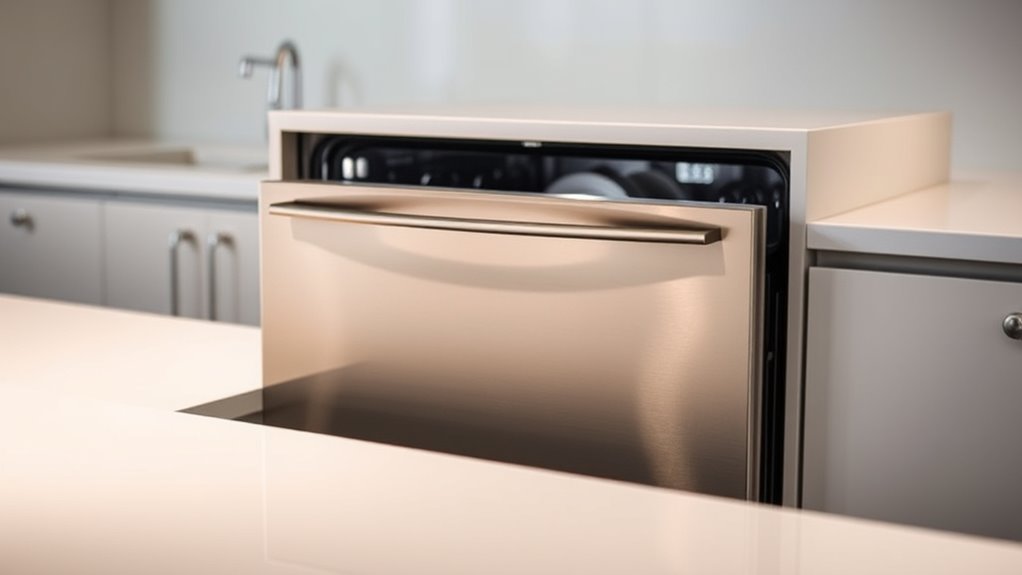Quiet dishwashers typically operate at or below 45 decibels, making them barely noticeable during cycles. The lower the decibel level, the quieter the machine sounds—most models range from 40 to 60 dB. Proper placement, soundproofing, and insulation can enhance their silent operation. Hidden features like vibration dampeners and sound-absorbing materials also help reduce noise. Want to discover how to test and maintain your dishwasher for ideal peace and quiet? Keep exploring for more tips.
Key Takeaways
- Quiet dishwashers operate at or below 45 dB, ensuring minimal disturbance during use.
- Factors like motor design, insulation, and vibration dampening significantly influence noise levels.
- Proper placement and soundproofing techniques enhance the perceived quietness of your dishwasher.
- Regular maintenance of filters, seals, and spray arms prevents noise caused by debris or loose parts.
- Using anti-vibration pads and avoiding overloading can further reduce operational noise.
Understanding Decibel Levels in Dishwashers

Understanding decibel levels in dishwashers is essential if you want a quieter kitchen experience. Your dishwasher’s placement can markedly influence how noise travels through your home. Installing it in a cabinet or away from living areas helps reduce sound transmission. When shopping for a dishwasher, look at the noise level standards, typically measured in decibels (dB). Most models operate between 40-60 dB, with quieter units around 45 dB or lower. Knowing these levels helps you choose a machine that fits your need for quietness. Keep in mind that the lower the decibel number, the quieter the dishwasher. Proper placement combined with understanding noise level standards ensures you’ll enjoy a peaceful, less disruptive kitchen environment. Additionally, selecting a model with a reduced noise design can further enhance your kitchen’s tranquility.
What Counts as a Quiet Dishwasher?

A dishwasher qualifies as quiet when its noise level falls at or below 45 decibels, making it barely noticeable during operation. Proper dishwasher placement can help maximize this quietness—placing it away from living areas or installing it in a soundproofed cabinet reduces perceived noise. Noise level standards are set to ensure appliances don’t disturb your home environment, and many modern dishwashers meet or exceed these benchmarks. Look for models that specify their decibel ratings; anything below 45 dB is considered quiet. Keep in mind that the overall noise you experience depends not only on the machine’s rating but also on how and where it’s installed. Choosing a dishwasher with a low decibel level and strategic placement guarantees a quieter, more comfortable kitchen experience. Understanding AI security vulnerabilities can help manufacturers develop safer appliances and improve noise reduction features.
Factors Influencing Noise Output

Your dishwasher’s noise level depends on several key factors. The design of the motor and pump, along with insulation and soundproofing, can markedly reduce sound. Additionally, load size and cycle settings play a role in how loud your dishwasher becomes during operation. For example, choosing a Kia Tuning approach to modify components for noise reduction can further decrease operational sound levels.
Motor and Pump Design
The design of the motor and pump plays an essential role in determining how loud a dishwasher operates. A motor with high efficiency reduces energy waste and minimizes vibrations that can cause noise. When the motor runs smoothly, it produces less hum and rattling, contributing to quieter operation. Similarly, pump design impacts noise levels considerably. Pumps engineered for noise reduction incorporate quieter components and optimized placement to lessen sound emissions during operation. By focusing on motor efficiency, manufacturers can decrease electrical and mechanical noise, while pump innovations help dampen sound vibrations. Additionally, the use of self-watering plant pots as a metaphor highlights the importance of thoughtful design in reducing unwanted vibrations and noise. Overall, thoughtful motor and pump design are crucial for achieving a quieter dishwasher, ensuring your kitchen stays peaceful during cycles without sacrificing cleaning performance.
Insulation and Soundproofing
Have you ever wondered why some dishwashers run almost silently while others seem loud even at low cycles? The answer lies in insulation and soundproofing. High-quality soundproofing materials and effective insulation techniques can markedly reduce noise output. These materials absorb vibrations and block sound waves, preventing noise from escaping. Incorporating eco-friendly options can further enhance the sustainability of your soundproofing setup.
| Soundproofing Materials | Insulation Techniques |
|---|---|
| Acoustic foam | Layered insulation |
| Mass-loaded vinyl | Enclosed panels |
| Rubber grommets | Soundproof lining |
| Mineral wool | Sealed cabinet |
Choosing the right combination of soundproofing materials and insulation techniques makes your dishwasher quieter. Proper insulation ensures noise stays contained, giving you a peaceful kitchen environment.
Load and Cycle Settings
Load size and cycle settings considerably influence how loud a dishwasher operates. When you overload it beyond the recommended load capacity, the machine has to work harder, increasing noise levels. Similarly, choosing longer cycle durations, like heavy or intensive cycles, tends to produce more noise due to extended motor and pump operation. Opting for a shorter, eco-friendly cycle can reduce overall noise, especially if your dishes aren’t heavily soiled. Balancing load size and cycle choice helps maintain quieter operation. Avoid stuffing the dishwasher too full or selecting overly long cycles, as both can lead to increased noise. Additionally, understanding how vertical storage solutions and organization can help optimize space and reduce clutter, indirectly contributing to a more efficient and quieter kitchen environment. By understanding how load capacity and cycle duration impact sound output, you can optimize your dishwasher’s performance for a quieter kitchen environment.
Hidden Noise-Reducing Features to Look For

While many dishwasher features are visible and easy to identify, some of the most effective noise-reducing elements are hidden beneath the surface. Look for appliances with soundproof materials that absorb and block noise, preventing sound from escaping. Vibration dampening is also vital; it minimizes movement and rattling during operation. Inside, you might find insulation layers designed specifically to absorb sound waves. Additionally, some models incorporate anti-vibration pads under the dishwasher’s legs, reducing transmission of vibrations to the floor. These hidden features work together to create a quieter environment, ensuring your dishwasher runs smoothly without disturbing your peace. An understanding of contrast ratio can also help you select models with better overall performance, including quieter operation. Keep an eye out for these subtle yet powerful elements when shopping for a silent dishwasher.
How to Test and Compare Dishwasher Silence

To effectively compare dishwasher silence, start by listening carefully during different cycles, ideally in a quiet environment where background noise is minimal. Conduct dishwasher sound testing by noting the volume levels at various points—wash, rinse, and dry. Use a decibel meter if possible for precise quietness comparison. Focus on how loud or soft the dishwasher sounds during operation. Imagine these scenarios:
| Cycle Stage | Sound Level (Estimate) |
|---|---|
| Washing | Quiet, around 50 dB |
| Rinsing | Slightly louder, 55 dB |
| Drying | Near silent, 45 dB |
| Idle | Almost silent, below 40 dB |
This helps you gauge true silence and compare models effectively, ensuring your dishwasher’s noise level matches your quietness preference. Considering the noise levels in different models can help you choose the best one for your home environment.
Tips for Maintaining a Quiet Dishwashing Experience

Maintaining a quiet dishwashing experience requires regular care and mindful practices that prevent unnecessary noise. Proper dishwasher placement is essential; guarantee it’s level and away from walls or cabinets that can amplify sound. Incorporate consistent maintenance routines, like cleaning filters and spray arms, to keep your dishwasher running smoothly. Check for loose parts or worn-out seals that might cause rattling or noise. Additionally, avoid overloading the machine, which can strain components and increase noise levels. To visualize, imagine:
- Placing your dishwasher on a stable, level surface
- Regularly cleaning filters and spray arms
- Tightening loose screws or seals promptly
- Not overstuffing dishes to prevent strain
- Using soundproof mats underneath your dishwasher can also significantly reduce noise and vibrations.
Following these tips helps sustain a quieter, more efficient dishwashing experience.
Frequently Asked Questions
Are Quieter Dishwashers More Energy-Efficient?
Yes, quieter dishwashers often use less energy because their advanced insulation and efficient motors reduce noise and power consumption. When you choose a quieter model, you’re likely also lowering your energy consumption, which benefits the environment by reducing your overall environmental impact. These dishwashers tend to operate more smoothly and efficiently, making them a smart choice for energy-conscious homeowners who want to save money and minimize their ecological footprint.
How Does Dishwasher Placement Affect Noise Levels?
You might think placement doesn’t matter, but it does—proper dishwasher placement substantially reduces noise. Position your dishwasher away from living areas and consider soundproofing techniques, like adding insulation or anti-vibration pads. Installing it in a cabinet or using soundproof panels minimizes sound transmission. By strategically placing your dishwasher, you create a quieter environment and enhance your home’s comfort while still enjoying efficient cleaning.
Can Installation Errors Increase Dishwasher Noise?
Yes, installation mistakes can increase dishwasher noise. If you don’t guarantee proper placement, it can cause vibrations and rattling sounds. Missing or inadequate dishwasher insulation also amplifies noise, making it louder during cycles. You should double-check that all components are correctly installed and insulated to minimize noise. Addressing these issues early can considerably reduce the sound levels, creating a quieter and more comfortable kitchen environment.
Do Noise Levels Vary Between Different Dishwasher Brands?
Yes, noise levels vary between different dishwasher brands. You’ll notice some brands with a strong reputation for quiet operation, thanks to their technological innovations. These brands invest in soundproofing and advanced insulation, making their dishwashers considerably quieter. When choosing a brand, consider their reputation for noise control and innovative features, which can guarantee you get a quieter dishwasher that fits your needs and lifestyle.
How Often Should I Service My Dishwasher to Maintain Quiet Operation?
A stitch in time saves nine—so, you should service your dishwasher every 6 to 12 months. Regular maintenance keeps it running smoothly and minimizes noise. Follow a maintenance schedule that includes cleaning filters, checking spray arms, and inspecting seals. For noise reduction tips, make sure nothing obstructs the spray arms and keep the door gasket clean. Staying proactive ensures your dishwasher stays quiet and efficient for years to come.
Conclusion
Now that you know what makes a dishwasher quiet, are you ready to choose one that won’t disrupt your peace? By understanding decibel levels, features, and maintenance tips, you can enjoy a calmer kitchen environment. Remember, silence isn’t just a luxury — it’s about creating a more comfortable home. So, next time you shop for a dishwasher, will you prioritize quietness and make your daily chores a little more peaceful?










